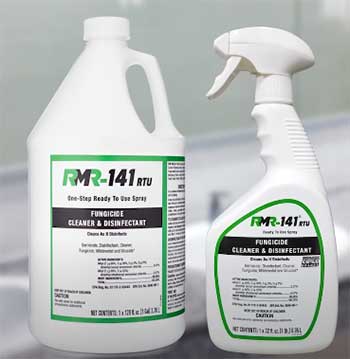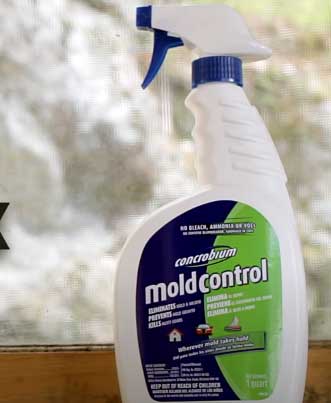Let’s have a candid discussion about a topic that’s a common headache for many homeowners: mold removal. Today, we’re focusing on two popular products, RMR-141 and Concrobium.
Both are highly respected in the market, but how do they stack up against each other?
Let’s dive right in.
A Brief Comparison Table
| Feature | RMR-141 | Concrobium |
| Composition | Potent biocide | Non-toxic tri-salt polymer |
| Strength | Very high | High |
| Mode of Action | Kills on contact | Kills and prevents growth |
| Residual Effect | No | Yes |
| Versatility | High | Very high |
| Corrosiveness | Potentially Yes | No |
| Safety for Pets/Kids | Caution required | Generally safe |
| Application Process | Spray and wipe | Spray and let dry |
| Odor Elimination | Yes | No |
| Antimicrobial Barrier | No | Yes |
The Rundown on RMR-141
RMR-141, a potent biocide, is often celebrated as a mold-killer extraordinaire. This EPA-registered product works like a charm, tackling an impressive variety of bacteria, viruses, fungi, mold, and mildew. No doubt, it’s a versatile player in your home-cleaning arsenal.
Pros of RMR-141

- Strength: When it comes to eliminating mold and mildew, RMR-141 is a force to reckon with. This product effectively kills a wide range of pathogens, ensuring your home is safe from harmful microbes.
- Easy application: RMR-141 comes ready to use, no dilution necessary. Just point and spray, and you’re good to go.
- Odor Elimination: Besides eradicating mold, RMR-141 also dispels musty odors, leaving your living spaces smelling fresh and clean.
Cons of RMR-141
- Corrosiveness: As potent as RMR-141 is, its strength also implies a potential downside – it can be corrosive to certain surfaces. Always test on a small area before full application.
- Residual Effect: Unlike some mold removers, RMR-141 doesn’t offer a residual effect. Once you’ve sprayed and wiped it off, its mold-killing action ceases.
All About Concrobium
Next up is Concrobium, a unique, non-toxic mold solution. Unlike most mold killers, Concrobium doesn’t rely on harsh chemicals, which is a significant plus for eco-conscious users.
Pros of Concrobium
- Non-Toxic: As already mentioned, Concrobium is devoid of harsh, toxic chemicals. This makes it an excellent choice for homes with children, pets, or people with chemical sensitivities.
- Residual Effect: Once applied, Concrobium creates an invisible antimicrobial barrier, preventing future mold growth. A protective coating that lasts? Yes, please!
- Versatility: Concrobium is safe for a variety of surfaces, including drywall, concrete, wood, masonry, siding, shingles, and many more.
Cons of Concrobium
- Less Effective on Deeply-Embedded Mold: While Concrobium is a formidable opponent for surface mold, it may struggle to eliminate mold that’s deeply ingrained in porous materials.
- Application Process: Applying Concrobium requires a bit more work than simply spraying it on. It has to dry on the surface to create the antimicrobial barrier, which can be time-consuming.
Key Differences Between RMR-141 and Concrobium
While both RMR-141 and Concrobium are acclaimed mold removal products, they aren’t clones. Below, we’ll take a closer look at their key differences.
- Chemical Composition

One of the most notable differences between RMR-141 and Concrobium is their composition.
RMR-141 is a strong biocide, consisting of chemicals specifically designed to kill a broad range of pathogens, including bacteria, viruses, and fungi.
It’s a potent solution that gets the job done, even with stubborn infestations.
On the contrary, Concrobium is a non-toxic mold solution.
It does not rely on harsh chemicals to eliminate mold.
Instead, it uses a tri-salt polymer that physically crushes and suffocates mold spores as it dries, making it a safer option for households with children, pets, or anyone with chemical sensitivities.
- Mode of Action
RMR-141 works by directly killing mold and other pathogens upon contact. Once you’ve sprayed and wiped it off, its mold-killing action ceases. It’s essentially a one-and-done solution – it does not prevent future mold growth.
Concrobium, on the other hand, kills mold spores and then forms an invisible antimicrobial shield that continues to work long after initial application. This barrier prevents new mold spores from growing, giving it a leg up in terms of long-term protection.
- Versatility and Safety
RMR-141’s high potency makes it highly effective, but it also means it can be corrosive to certain materials. It’s crucial to test this product on a small, inconspicuous area first to avoid any potential damage.
Concrobium is much gentler and safe for a wide variety of surfaces. It’s suitable for drywall, concrete, wood, masonry, siding, shingles, and many other materials. Furthermore, its non-toxic formula ensures it’s safe for both the environment and your family.
In sum, while both RMR-141 and Concrobium are effective in fighting mold, their methods, composition, and after-effects are quite different. RMR-141 delivers a powerful punch, taking out mold spores decisively, while Concrobium offers a safe, gentle solution that keeps working over time.
Both have a place in your mold-fighting arsenal – your choice will depend on your specific needs and circumstances.
So, when it comes down to the nitty-gritty, which product is the champ – RMR-141 or Concrobium?
The answer depends on your specific needs. RMR-141 is your go-to for hardcore, swift mold elimination. If you have a severe infestation and you’re not concerned about potential corrosiveness, RMR-141 is a fantastic choice.
On the other hand, if you’re dealing with surface mold or want a non-toxic alternative that provides a lasting barrier against mold regrowth, Concrobium could be your hero.
Its safety and eco-friendliness are significant selling points, but you may need to put in more elbow grease to ensure it works effectively.
Frequently Asked Questions (FAQ)
RMR-141 is widely recognized as one of the strongest mold killers on the market. It’s a potent biocide, capable of eradicating a wide range of microbes, including stubborn molds.
Concrobium is an excellent product for mold removal, particularly for surface mold. Its non-toxic formula and lasting barrier against mold regrowth are major plus points. But remember, it might struggle with deeply-embedded mold.
Both RMR-141 and Concrobium work well on drywall. However, due to its non-corrosive nature and residual effect, Concrobium might be a slightly better choice for drywall.
Yes, RMR-141 effectively kills a wide range of mold species. Its potency in eliminating mold and mildew has made it a popular choice among homeowners and cleaning professionals alike.
Wrapping Up
In conclusion, both RMR-141 and Concrobium have their unique strengths and shortcomings. Your choice between them should hinge on the severity of the mold infestation, the materials in your home, and your personal health and eco-friendly preferences.
As always, remember to follow all safety guidelines when using these products. Happy mold hunting!

This information was exactly what I was looking for, thank you!
Amy